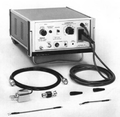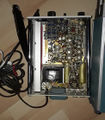P6042: Difference between revisions
No edit summary |
No edit summary |
||
| Line 10: | Line 10: | ||
|designers=Cal Hongel; | |designers=Cal Hongel; | ||
|manuals= | |manuals= | ||
* [ | * [[Media:070-0629-00.pdf|Tektronix P6042 Manual]] | ||
}} | }} | ||
The '''Tektronix P6042''' is a DC to 50 MHz current probe [[introduced in 1967]]. It was designed by [[Cal Hongel]]. | The '''Tektronix P6042''' is a DC to 50 MHz current probe [[introduced in 1967]]. It was designed by [[Cal Hongel]]. | ||
| Line 33: | Line 33: | ||
The P6042's core halves are precision lapped and potted with epoxy. They have Mu-metal screening. The lower (fixed) core also contains the Hall element. | The P6042's core halves are precision lapped and potted with epoxy. They have Mu-metal screening. The lower (fixed) core also contains the Hall element. | ||
Unfortunately, the P6042 probe is quite sensitive mechanically, and in many units offered for sale, the cores are damaged. | Unfortunately, the P6042 probe is quite sensitive mechanically, and in many units offered for sale, the cores are damaged. | ||
The amplifier front-end is constructed using a 156-0014-00 differential amplifier integrated circuit, labelled "M18", which [[Media:Tektronix_Xref_sm.pdf|cross-references]] to a long-obsolete Teledyne "831-BE". [[Jim Williams]]' [https://www.analog.com/media/en/technical-documentation/application-notes/an61fa.pdf Applicaion Note 61] contains a replacement circuit using LT1228 opamps. | |||
==Prices== | ==Prices== | ||
Revision as of 07:26, 13 July 2022
The Tektronix P6042 is a DC to 50 MHz current probe introduced in 1967. It was designed by Cal Hongel.
The sensor contains a current transformer for HF and a hall effect sensor for LF/DC components. The amplifier combines DC/LF and HF signals.
The AM503, introduced about a decade later, is a redesign of the P6042 with removable probes.
Key Specifications
| Bandwidth | DC to 50 MHz (−3 dB) |
|---|---|
| Rise time | 7 ns |
| Ranges | 1 mA/div to 1 A/div (1–2–5) with scope in 50 mV/div |
| Output | to 50 Ω scope input at 50 mV/div |
| Maximum input | 10 A DC+peak AC in 5 mA to 1 A ranges, 0.5 A in 1 mA and 2 mA ranges |
| Power | 90-136 or 180-272 V, 20 W |
Internals
Locking the probe requires pushing past the resistance felt when the core almost closes. This engages a mechanism that firmly presses both core halves together, and extinguishes the "Probe unlocked" indicator.
The P6042's core halves are precision lapped and potted with epoxy. They have Mu-metal screening. The lower (fixed) core also contains the Hall element. Unfortunately, the P6042 probe is quite sensitive mechanically, and in many units offered for sale, the cores are damaged.
The amplifier front-end is constructed using a 156-0014-00 differential amplifier integrated circuit, labelled "M18", which cross-references to a long-obsolete Teledyne "831-BE". Jim Williams' Applicaion Note 61 contains a replacement circuit using LT1228 opamps.
Prices
- $525 in 1967 (~$5,500 in 2022 Dollars)
Links
- Service Scope 46, October 1967
- Tek P6042 page @ amplifier.cd
- Tek P6042 page @ barrytech.com
- Tek P6042 page @ radiomuseum.org
- P6042 repair by Fred, PA4TIM
- P6042 teardown @ EEtimes
Pictures
-
amplifier front
-
amplifier and sensor
-
sensor detail
-
rear view
-
catalog image
-
P6042 amplifier internal view
-
P6042 amplifier internal view
-
P6042 amplifier internal view
-
Top half core of probe
-
Bottom of probe with half core and Hall sensor










